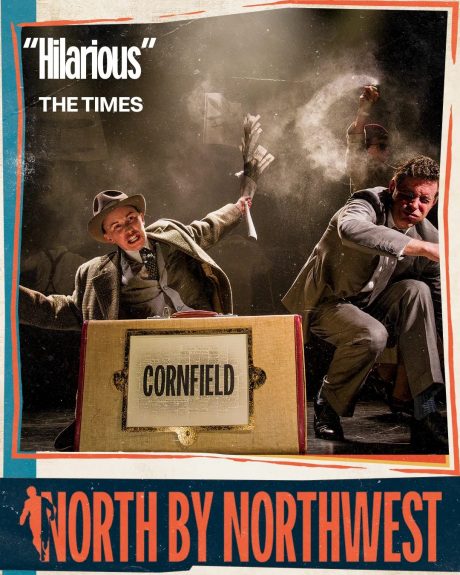
- A Classic Film Can Be Reimagined as a Theatrical Ballet of Identity
Watching North by Northwest live on stage taught me that Hitchcock’s iconic thriller can be powerfully transformed into a live performance without losing its essence. Like The 39 Steps stage adaptation, this production embraces a minimalist, stylised approach, yet it never slips into parody. Instead of mimicking the film’s aesthetic, it reinvents it. Gone is Bernard Herrmann’s dramatic score; in its place, a playlist of vintage 1950s and earlier tracks, Billie Holiday among them, infuse scenes with a smoky, nostalgic glamour. The actors sometimes lip-sync or dance to these songs, turning the show into a kind of movement piece. It made me see the film anew: as a kind of dance all along, one of mistaken identities, shifting roles, and elegant deception. Roger Thornhill, once embodied by the polished Cary Grant, is now played as an everyman: awkward, vulnerable, and unexpectedly moving. - Minimalism Can Unlock Maximum Imagination
The set consists of four large revolving doors, which open, close, and spin to create shifting locations: cocktail bars, hotel lobbies, and train compartments. For the final Mount Rushmore sequence, the doors are wheeled offstage, and the actors use only suitcases and physicality to convey the dizzying heights and danger. The cleverness lies not in special effects but in suggestion, and in trusting the audience’s imagination. This minimalism accentuates the play’s existential undertones: the surreal atmosphere owes more to Kafka than Hitchcock at times. And with a woman narrator, part ringmaster, part guide, who calls out names, organises the action, and even leads us in a game of “Simon Says,” we are reminded that we’re watching a story unfold. One that, like Heidegger’s notion of Dasein, shows us thrown into roles, identities, situations beyond our control. - The Adaptation Has Real Emotional and Political Weight
What surprised me most was the emotional depth and political reimagining. While much of the film’s original dialogue is retained; especially in key scenes like the kidnapping and the auction—there are significant additions and reframings. Thornhill’s wartime past, left unspoken in the film, is now openly acknowledged, giving weight to his trauma and detachment. Eve Kendall is no longer just a glamorous femme fatale; she’s recast as foreign, politically radical, and deeply principled. By the play’s end, she’s an Eve of a new era: a Kennedy or King-like figure, calling for freedom, honesty, and openness. She becomes the moral centre of the piece, and her relationship with Thornhill is infused with warmth, humour, and mutual recognition. His confession that he lacked compassion in previous marriages adds surprising vulnerability to a character often played for charm alone. - The Play is Smart, Funny, and Sincere—Never a Spoof
What the production gets exactly right is tone. There is wit and theatrical flair, particularly in the choreography, the musical choices, and the self-aware narrator—but there is no mockery. The 1959 period dialogue is delivered with a light touch but always respectfully, never as pastiche. The villains are subtly updated: Thornhill’s mother is far more domineering than Jesse Royce Landis in the film, hitting Roger at points; Philip Vandamm is much more hysterical and disturbed than the cool portrayal of James Mason; Leonard is renamed, made more openly gay and foreign, while his fellow henchmen become a woman who is in love with him; changes that deepen rather than distort the story. The famous crop-duster scene is the one moment that felt slightly underpowered, its narration arguably unnecessary given its iconic status, but overall, the adaptation balances suspense, philosophy, and playfulness. It’s a reflection on identity, storytelling, surveillance, and freedom in a conflicted world, not just in 1959, but now.


Leave a Reply